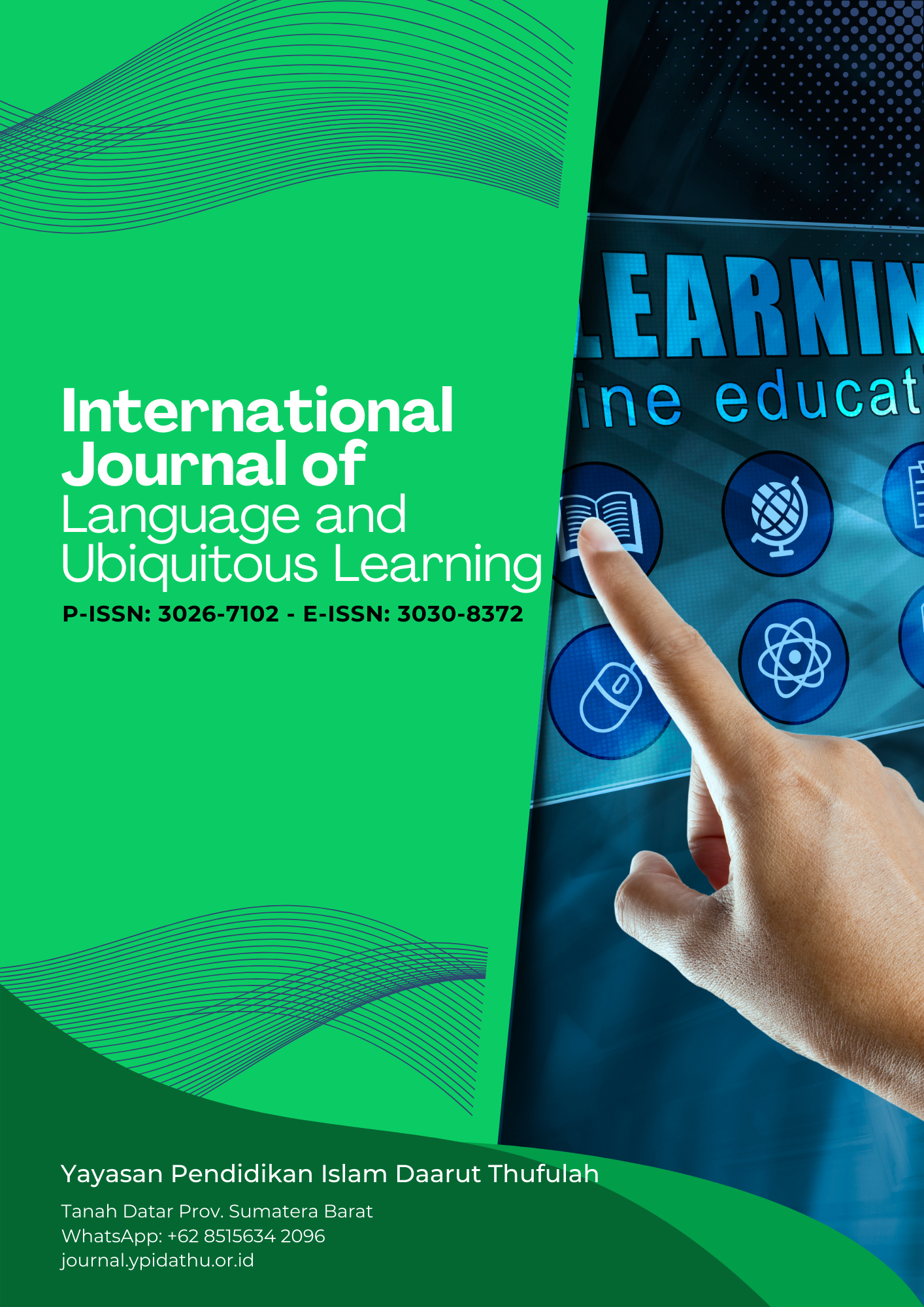Micro and Macro Approaches in Linguistics for Method Development
Abstract
Background. Micro and macro approaches in linguistics have long been two methods used separately in language research. The micro approach focuses on the technical structure of the language, such as grammar, phonology, and syntax, while the macro approach examines how language is used in a broader social context. However, the separation of these two approaches often creates a gap in understanding the overall use of language.
Purpose. This research aims to develop a method that integrates micro and macro approaches in linguistic studies, especially in Japanese.
Method. The research method used was mixed, in which quantitative data was collected through a questionnaire from 52 native Japanese speaking respondents, and qualitative data was obtained through in-depth interviews with 10 participants. This study examines how Japanese speakers use language structures in various social contexts, both formal and informal.
Results. The results showed that an understanding of the technical structure of language helps speakers in formal situations, such as in the workplace, while social adaptation is necessary in more relaxed situations, such as social media. The integration between micro and macro approaches provides a more comprehensive understanding of how language is used in everyday life.
Conclusion. In conclusion, a method that combines these two approaches is essential to get a more complete picture of the dynamics of language use.
Full text article
References
Andi Irma, S. (2023). KONSTRUKSI PASIF BAHASA JEPANG DALAM WACANA EKSPLANASI. Jurnal Ilmiah Sosial Humaniora (Social Humanities Scientific Journal), 1, 19–28.
Arianto, A., & Fadly, A. (2020). Ideologi Penerjemahan Kata Budaya dari Bahasa Indonesia ke dalam Bahasa Jepang. Jurnal Bahasa Jepang Taiyou, 1(2), 46–61.
Berman, A. (2022). Linguistic structures and innovation: A behavioral approach. Journal of International Management, 28(4). https://doi.org/10.1016/j.intman.2022.100943
Bürki, Y. (2020). Connecting micro and macro sociolinguistic processes through narratives. A glottopolitical Gaze. Journal of multilingual and multicultural development, 41(1), 12–24.
Chen, Y. (2020). RESEARCH on QUANTITATIVE EVALUATION METHOD of REASONABLE OIL RECOVERY RATE in OIL and GAS FIELD DEVELOPMENT. Fresenius Environmental Bulletin, 29(4), 2540–2546.
Chen, Y. (2022). Research on Quantitative Optimization Method Based on Incremental Optimization. Lecture Notes in Computer Science (including subseries Lecture Notes in Artificial Intelligence and Lecture Notes in Bioinformatics), 13395(Query date: 2023-11-30 23:13:48), 729–740. https://doi.org/10.1007/978-3-031-13832-4_60
Egorov, K. (2021). Research methodology for quantitative and qualitative parameters of parking space use. Procedia Computer Science, 193(Query date: 2023-11-21 20:22:48), 62–71. https://doi.org/10.1016/j.procs.2021.10.007
England, A. (2022). Quantitative and qualitative research methods. Research for Medical Imaging and Radiation Sciences, Query date: 2023-11-30 23:13:48, 71–96. https://doi.org/10.1007/978-3-030-79956-4_5
Ewing, R. (2020a). ADVANCED QUANTITATIVE RESEARCH METHODS FOR URBAN PLANNERS. Dalam Advanced Quantitative Research Methods for Urban Planners (hlm. 298). https://doi.org/10.4324/9780429325038
Ewing, R. (2020b). Basic quantitative research methods for urban planners. Dalam Basic Quantitative Research Methods for Urban Planners (hlm. 328). https://doi.org/10.4324/9780429325021
Fadhila, M. I. (2016). Variasi Bahasa pada Akun Instagram@ D_Kadoor: Kajian Sosiolinguistik.
Hung, B. P. (2019). A cognitive linguistic approach to teaching English idioms to EFL students: Experimental results. 3L: Language, Linguistics, Literature, 25(2), 113–126. https://doi.org/10.17576/3L-2019-2502-09
Juybari, M. S. (2020). Cultural Linguistics and ELT curriculum: The case of ‘Prospect’ English textbooks in Iran. International Journal of Applied Linguistics (United Kingdom), 30(3), 479–496. https://doi.org/10.1111/ijal.12301
Kalina, R. M., & Bagi?ska, J. (2023). Language of Innovative Agonology: A Guide in Combining Micro and Macro Scales of Preventive, Therapeutic and Defensive Actions. 20–24.
Kharisma, C. C. S., Lubis, F. O., & Lubis, F. M. (2023). Pengaruh Penggunaan Akun Instagram@ pocketnihongo. Id terhadap Pemenuhan Kebutuhan Informasi followers Seputar Bahasa Jepang. Jurnal Pendidikan Tambusai, 7(2), 10361–10366.
Liddicoat, A. J. (2020). 17 Language policy and planning for language maintenance: The macro and meso levels. Dalam Handbook of home language maintenance and development (hlm. 337–356). De Gruyter Mouton.
Malkin, D. (2022). A Balanced Data Approach for Evaluating Cross-Lingual Transfer: Mapping the Linguistic Blood Bank. NAACL 2022 - 2022 Conference of the North American Chapter of the Association for Computational Linguistics: Human Language Technologies, Proceedings of the Conference, Query date: 2024-10-12 13:48:30, 4903–4915.
Mustafa, P., Gusdiyanto, H., & ... (2022). Metodologi Penelitian Kuantitatif, Kualitatif, dan Penelitian tindakan kelas dalam pendidikan olahraga. Insight …, Query date: 2024-06-15 20:09:03. https://repository.insightmediatama.co.id/books/article/view/21
Orcasitas-Vicandi, M. (2022). Towards a multilingual approach in assessing writing: Holistic, analytic and cross-linguistic perspectives. International Journal of Bilingual Education and Bilingualism, 25(6), 2186–2207. https://doi.org/10.1080/13670050.2021.1894089
Palfreyman, N. (2020). Macro and micro-social variation in Asia-Pacific sign languages. Asia-Pacific Language Variation, 6(1), 1–12.
Priadana, M. S., & Sunarsi, D. (2021). Metode Penelitian Kuantitatif. Pascal Books.
Rezapour, E. (2021). The role of gender in producing linguistic variation in persian translations of “Metamorphosis” by Franz Kafka: An interface between sociolinguistics and generative grammar. Language Related Research, 11(6), 539–574.
Riandi, R., & Nupus, H. (2022). Kebijakan Bahasa dalam Lanskap Linguistik di Era Super-Diversity: Bahasa Asing (Bahasa Inggris) di Ruang Publik. MENDIDIK: Jurnal Kajian Pendidikan dan Pengajaran, 8(2), 278–283.
Sharifi, S. (2020). Macro and micro analysis. The Routledge Handbook of Translation, Feminism and Gender.
Vocroix, L. (2021). Morphology in micro linguistics and macro linguistics. Macrolinguistics and Microlinguistics, 2(1), 1–20.
Authors
Copyright (c) 2024 Umul Khasanah

This work is licensed under a Creative Commons Attribution-ShareAlike 4.0 International License.





